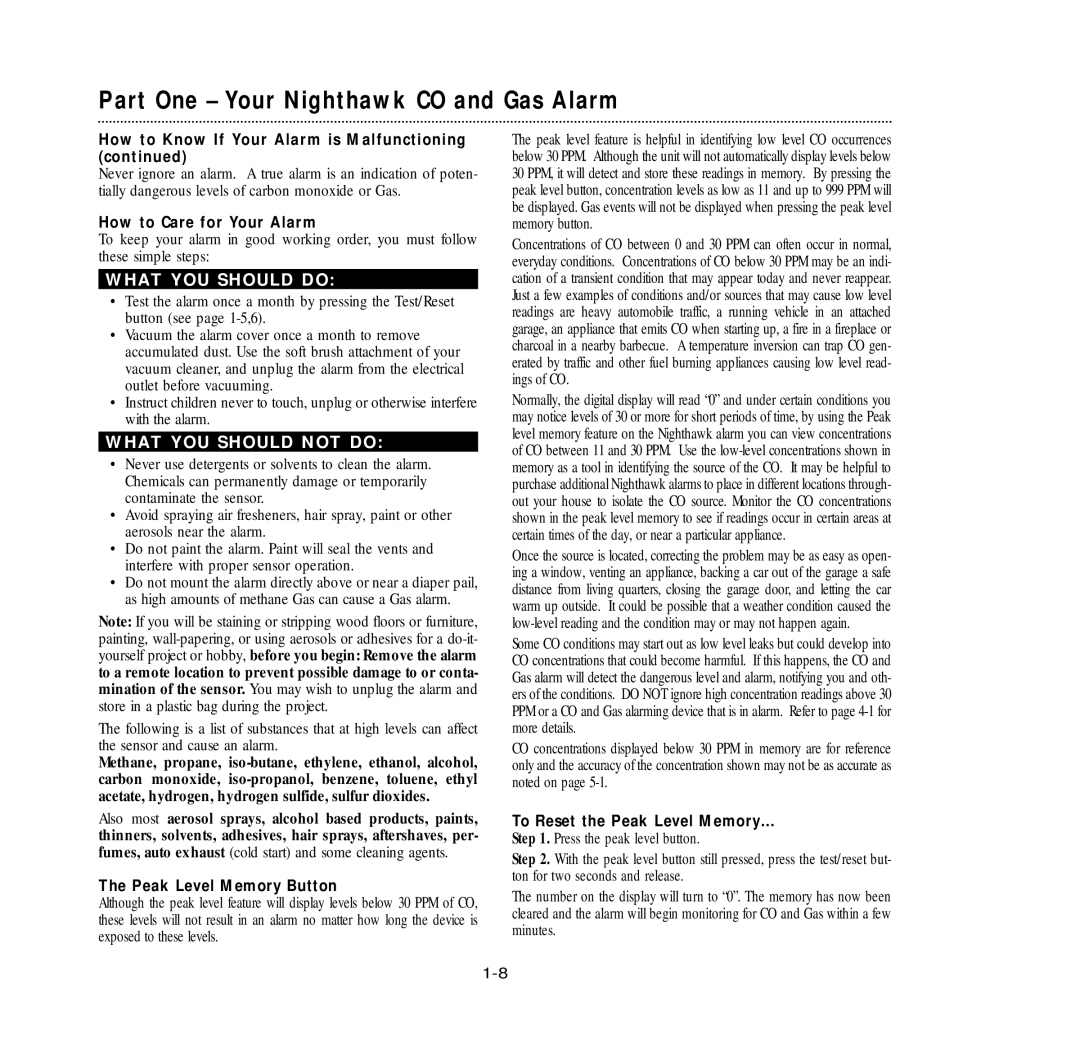How to Know If Your Alarm is Malfunctioning (continued)
Never ignore an alarm. A true alarm is an indication of poten- tially dangerous levels of carbon monoxide or Gas.
How to Care for Your Alarm
To keep your alarm in good working order, you must follow these simple steps:
WHAT YOU SHOULD DO:
•Test the alarm once a month by pressing the Test/Reset button (see page 1-5,6).
•Vacuum the alarm cover once a month to remove accumulated dust. Use the soft brush attachment of your vacuum cleaner, and unplug the alarm from the electrical outlet before vacuuming.
•Instruct children never to touch, unplug or otherwise interfere with the alarm.
WHAT YOU SHOULD NOT DO:
•Never use detergents or solvents to clean the alarm. Chemicals can permanently damage or temporarily contaminate the sensor.
•Avoid spraying air fresheners, hair spray, paint or other aerosols near the alarm.
•Do not paint the alarm. Paint will seal the vents and interfere with proper sensor operation.
•Do not mount the alarm directly above or near a diaper pail, as high amounts of methane Gas can cause a Gas alarm.
Note: If you will be staining or stripping wood floors or furniture, painting, wall-papering, or using aerosols or adhesives for a do-it- yourself project or hobby, before you begin: Remove the alarm to a remote location to prevent possible damage to or conta- mination of the sensor. You may wish to unplug the alarm and store in a plastic bag during the project.
The following is a list of substances that at high levels can affect the sensor and cause an alarm.
Methane, propane, iso-butane, ethylene, ethanol, alcohol, carbon monoxide, iso-propanol, benzene, toluene, ethyl acetate, hydrogen, hydrogen sulfide, sulfur dioxides.
Also most aerosol sprays, alcohol based products, paints, thinners, solvents, adhesives, hair sprays, aftershaves, per- fumes, auto exhaust (cold start) and some cleaning agents.
The Peak Level Memory Button
Although the peak level feature will display levels below 30 PPM of CO, these levels will not result in an alarm no matter how long the device is exposed to these levels.
The peak level feature is helpful in identifying low level CO occurrences below 30 PPM. Although the unit will not automatically display levels below 30 PPM, it will detect and store these readings in memory. By pressing the peak level button, concentration levels as low as 11 and up to 999 PPM will be displayed. Gas events will not be displayed when pressing the peak level memory button.
Concentrations of CO between 0 and 30 PPM can often occur in normal, everyday conditions. Concentrations of CO below 30 PPM may be an indi- cation of a transient condition that may appear today and never reappear. Just a few examples of conditions and/or sources that may cause low level readings are heavy automobile traffic, a running vehicle in an attached garage, an appliance that emits CO when starting up, a fire in a fireplace or charcoal in a nearby barbecue. A temperature inversion can trap CO gen- erated by traffic and other fuel burning appliances causing low level read- ings of CO.
Normally, the digital display will read “0” and under certain conditions you may notice levels of 30 or more for short periods of time, by using the Peak level memory feature on the Nighthawk alarm you can view concentrations of CO between 11 and 30 PPM. Use the low-level concentrations shown in memory as a tool in identifying the source of the CO. It may be helpful to purchase additional Nighthawk alarms to place in different locations through- out your house to isolate the CO source. Monitor the CO concentrations shown in the peak level memory to see if readings occur in certain areas at certain times of the day, or near a particular appliance.
Once the source is located, correcting the problem may be as easy as open- ing a window, venting an appliance, backing a car out of the garage a safe distance from living quarters, closing the garage door, and letting the car warm up outside. It could be possible that a weather condition caused the low-level reading and the condition may or may not happen again.
Some CO conditions may start out as low level leaks but could develop into CO concentrations that could become harmful. If this happens, the CO and Gas alarm will detect the dangerous level and alarm, notifying you and oth- ers of the conditions. DO NOT ignore high concentration readings above 30 PPM or a CO and Gas alarming device that is in alarm. Refer to page 4-1 for more details.
CO concentrations displayed below 30 PPM in memory are for reference only and the accuracy of the concentration shown may not be as accurate as noted on page 5-1.
To Reset the Peak Level Memory…
Step 1. Press the peak level button.
Step 2. With the peak level button still pressed, press the test/reset but- ton for two seconds and release.
The number on the display will turn to “0”. The memory has now been cleared and the alarm will begin monitoring for CO and Gas within a few minutes.

